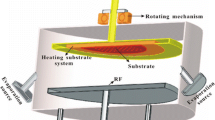Abstract
Stannous sulfide (SnS) was grown on SiO2/Si substrates via chemical vapor deposition technique and characterized using optical microscopy, scanning electronic microscopy, X-ray diffraction, Raman spectroscopy, transmission electron microscopy, atomic force microscopy and photoluminescence (PL) spectrum, respectively. The results indicate that SnS with two distinct morphologies of “the ultra-thin SnS flakes and the micron-thick SnS crystals” can be grown on different zones of the SiO2/Si substrate. The ultra-thin SnS flakes are single crystal with thickness of 139 nm and maximum lateral sizes of 371 μm. However, the micron-thick SnS crystals are 2.2 μm-thick and a lateral size of 15 μm with square shape. The difference in morphology between the ultra-thin SnS flakes and the micron-thick SnS crystals is mainly due to the difference in the initial nucleation way. Both the ultra-thin SnS flakes and the micron-thick SnS crystals are orthorhombic structure with high-purity. PL strong peak of the ultra-thin SnS flakes is at 950 nm, and it is at 945 nm for the micron-thick SnS crystals. Their optical band gap is approximately 1.31 eV.





Similar content being viewed by others
References
S. Sucharitakul, U. Rajesh Kumar, R. Sankar, screening limited switching performance of multilayer 2D semiconductor FETs: the case for SnS. Nanoscale 8(45), 19050–19057 (2016)
C. Guo, Z. Tian, J. Xue, R. Li, M. Zhao, Two-dimensional SnS: a phosphorene analogue with strong in-plane electronic anisotropy. ACS Nano 11(2), 2219–2226 (2017)
P. Sinsermsuksakul, L. Sun, S.W. Lee, H.H. Park, S.B. Kim, C. Yang, R.G. Gordon, overcoming efficiency limitations of SnS-based solar cells. Adv. Energ. Mater. 4(15), 1–7 (2014)
S. Gedi, V.R.M. Reddy, B. Pejjai, C.W. Jeon, C. Park, R.K.T. Ramakrishna, A facile inexpensive route for SnS thin film solar cells with SnS2 buffer. Appl. Surf. Sci. 372, 116–124 (2016)
Q. Li, A.X. Wei, J.T. Lu, L.L. Tao, Y.B. Yang, D.X. Luo, J. Liu, Y. Xiao, Y. Zhao, J.B. Li, synthesis of submillimeter-scale single crystal stannous sulfide nanoplates for visible and near-infrared photodetectors with ultrahigh responsivity. Adv. Electron. Mater. 4, 1800154 (2018). 1–8
Mohamed S. Mahdi, K. Ibrahim, A. Hmood, Naser M. Ahmed, Falah I. Mustafa, Shrook A. Azzez, High performance near infrared photodetector based on cubic crystal structure SnS thin film on a glass substrate. Mater. Lett. 200, 10–13 (2017)
G.Z. Liu, Y. Li, B. Li, H. Tian, C. Fan, Y.H. Zhang, Z.Q. Hua, M.J. Wang, H.X. Zheng, E.P. Li, High-performance photodetectors based on two-dimensional tin(II) sulfide (SnS) nanoflakes. J. Mater. Chem. C 6, 10036–10041 (2018)
E.C. Greyson, J.E. Barton, T.W. Odom, Tetrahedral zinc blende tin sulfide nano- and microcrystals. Small 2(3), 368–371 (2010)
J.H. Ahn, M.J. Lee, H. Heo, J.H. Sung, K. Kim, H. Hwang, M.H. Jo, Deterministic two-dimensional polymorphism growth of hexagonal n-type SnS2 and orthorhombic p-type SnS crystals. Nano Lett. 15(6), 3703–3708 (2015)
Z. Mutlu, R.J. Wu, D. Wickramaratne, S. Shahrezaei, C. Liu, S. Temiz, A. Patalano, M. Ozkan, R.K. Lake, K.A. Mkhoyan, C.S. Ozkan, Phase engineering of 2D tin sulfides. Small 12(22), 2998–3004 (2016)
X. Chao, J.X. Zheng, Y.T. Su, S.K. Li, B.K. Zhang, Y.C. Feng, few-layer tin sulfide: a new black-phosphorus-analogue 2D material with sizeable band gap, odd-even quantum confinement effect, and high carrier mobility. J. Phys. Chem. C 120(39), 22663–22669 (2016)
L. Makinistian, E.A. Albanesi, on the band gap location and core spectra of orthorhombic IV–VI compounds SnS and SnSe. Phys. Status Solidi 246(1), 183–191 (2010)
I.H. Baek, J.J. Pyeon, Y.G. Song, T.M. Chung, H.R. Kim, S.H. Baek, J.S. Kim, C.Y. Kang, J.W. Choi, C.V. Hwang, J.H. Han, S.K. Kim, Synthesis of SnS thin films by atomic layer deposition at low temperatures. Chem. Mater. 29, 8100–8110 (2017)
R. Browning, P. Plachinda, P. Padigi, R. Solanki, S. Rouvimov, Growth of multiple WS2/SnS layered semiconductor heterojunctions. Nanoscale 8, 2143–2148 (2016)
J. Xia, X.Z. Li, X. Huang, N. Mao, D.D. Zhu, L. Wang, H. Xu, X.M. Meng, Physical vapor deposition synthesis of two-dimensional orthorhombic SnS flakes with strong angle/temperature-dependent Raman responses. Nanoscale 8, 2063–2070 (2016)
H.D. Zhang, Y. Balaji, A.N. Mehta, M. Heyns, M. Caymax, I. Radu, W. Vandervorst, A. Delabie, Formation mechanism of 2D SnS2 and SnS by chemical vapor deposition using SnCl4 and H2S. J. Mater. Chem. C 6, 6172–6178 (2018)
A.N. Mehta, H. Zhang, A. Dabral, O. Richard, P. Favia, H. Bender, structural characterization of SnS crystals formed by chemical vapour deposition. J. Microsc. 268(3), 276–287 (2017)
J. Chao, Z. Wang, X. Xin, Q. Xiang, W. Song, C. Gui, Tin sulfide nano ribbons as high performance photoelectrochemical cells, flexible photodetectors and visible-light-driven photocatalysts. RSC Adv. 3(8), 2746–2753 (2013)
Y. Huang, E. Sutter, J.T. Sadowski, M. Cotlet, O.L.A. Monti, D.A. Racke, M.R. Neupane, D. Wickramaratne, R.K. Lake, B.A. Parkinson, P. Sutter, Tin disulfide-an emerging layered metal dichalcogenide semiconductor: materials properties and device characteristics. ACS Nano 8, 10743–10755 (2014)
H.R. Chandrasekhar, D.G. Mead, Long-wavelength phonons in mixed-valence semiconductor SnII SnIVS3. Phys. Rev. B 19(2), 932–937 (1979)
G.Z. Liu, Y. Li, B. Li, H. Tian, C. Fan, Y.H. Zhang, Z.Q. Hua, M.J. Wang, H.X. Zheng, E.P. Liu, High-performance photodetectors based on two-dimensional tin(II) sulfide (SnS) nanoflakes. J. Mater. Chem. C 6, 10036–10041 (2018)
D.I. Bletskan, M.M. Bletskan, K.E. Glukhov, electronic structure of tin monosulfide. J. Solid State Chem. 245, 34–44 (2017)
Acknowledgements
This work has been financially supported by the Science and Technology Program of the Guangdong Province of China (Grant No. 2016A010104020).
Author information
Authors and Affiliations
Corresponding author
Additional information
Publisher's Note
Springer Nature remains neutral with regard to jurisdictional claims in published maps and institutional affiliations.
Rights and permissions
About this article
Cite this article
Yu, D., Li, Q., Wei, A. et al. Synthesis and characterization of the ultra-thin SnS flakes and the micron-thick SnS crystals by chemical vapor deposition. J Mater Sci: Mater Electron 30, 10879–10885 (2019). https://doi.org/10.1007/s10854-019-01431-9
Received:
Accepted:
Published:
Issue Date:
DOI: https://doi.org/10.1007/s10854-019-01431-9




